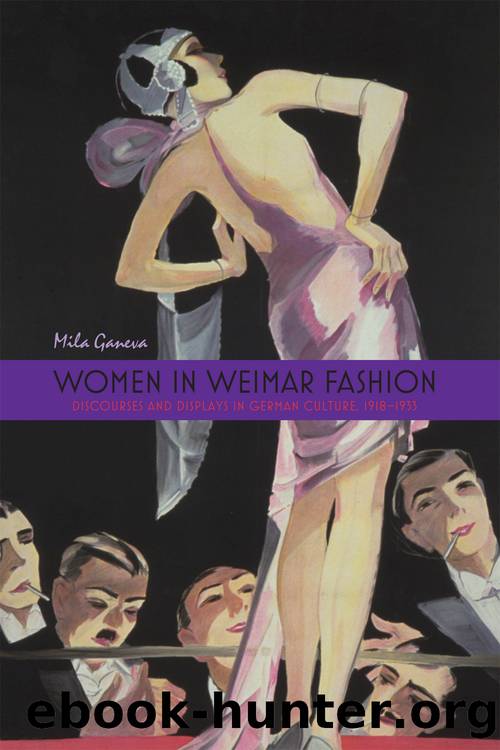Women in Weimar Fashion by Mila Ganeva

Author:Mila Ganeva
Language: eng
Format: epub
ISBN: 9781782044482
Publisher: Boydell & Brewer Group Ltd
Published: 2014-11-19T16:00:00+00:00
The Fashion Show: Origins and Appropriations
It was the Parisian couturier Charles Frederick Worth who introduced the live mannequin and invented the fashion show. Early in his career, when he was working as a salesman for a Parisian mercer, Worth observed specially hired young women who would walk around the premises modeling shawls while a sales pitch was made to a client.16 He was then convinced that clothing worn in movement (as opposed to the static display on a dummy) enhanced his clients’ visual and tactile experience of fashion and that this spectacle did, indeed, affect sales. When his own maison de couture opened in 1858, Worth hired several mannequins and made sure that they were always available to put on a dress for the inspection of a client. This novel practice established a firm connection between certain forms of exhibition and the volume of sales, between aesthetics and commerce, and was adopted by all upscale fashion salons throughout Europe in the later decades of the nineteenth century.17
The spectacular presentation of clothes took place not only in professional couture houses but also in a variety of other public spaces, such as at the races. There, as a visitor in Paris reported, “you will find all the leaders of fashion displaying the latest creations… the most striking and audacious gowns are worn by ‘mannequins’ or dressmakers’ models who are paid to be stared at.”18 In late nineteenth-century Paris, the racecourse at Longchamp and the Bois de Boulogne became the most fashionable parading grounds for dress. In Berlin it was the horse track in Grunewald and various private boating and yacht clubs on the lakes in the city’s southwest outskirts that became the trendy spots for the presentation of the latest models.19 During the 1920s, horse races at Grunewald, for example, became inseparable from the so-called “fashion races” (Moderennen): at regular intervals, a contemporary observer writes, “the poor horses are given half-an-hour break so that girls in furs, coats, and hats can perform a little trot on the glorious lawn.”20 Along with other public settings that attracted big crowds of fashion-conscious and relatively affluent people, such as parks, beaches, up-scale resorts, and hotels, racetracks remained important venues for the display of designers’ most recent creations everywhere in Europe, including Berlin, in the first three decades of the twentieth century and reinforced the trend toward the increased public visibility of fashions.
When turn-of-the-century stage productions started discovering the dramatic potential inherent in varying costumes, theater became another space for sartorial display. Realizing the increased importance and accessibility of fashion to the middle classes and in order to attract a wider female audience, dramatic productions began to mimic the presentational practices (die Vorführungen) common in the haute couture salons. The distinction between actresses and mannequins collapsed as fashion and theatre merged into the new genre of the “fashion play,” a form of musical comedy that stormed the stages of London, Paris, Berlin, and Vienna from the 1890s up to 1914.21 Similarly, the revue — specifically the
Download
This site does not store any files on its server. We only index and link to content provided by other sites. Please contact the content providers to delete copyright contents if any and email us, we'll remove relevant links or contents immediately.
Wonder by R.J. Palacio(8430)
Mastering Adobe Animate 2023 - Third Edition by Joseph Labrecque(3720)
Unlabel: Selling You Without Selling Out by Marc Ecko(3574)
Ogilvy on Advertising by David Ogilvy(3485)
Hidden Persuasion: 33 psychological influence techniques in advertising by Marc Andrews & Matthijs van Leeuwen & Rick van Baaren(3454)
Drawing Cutting Edge Anatomy by Christopher Hart(3440)
The Pixar Touch by David A. Price(3347)
POP by Steven Heller(3297)
The Code Book by Simon Singh(3057)
The Art of War Visualized by Jessica Hagy(2932)
Slugfest by Reed Tucker(2924)
The Curated Closet by Anuschka Rees(2897)
Rapid Viz: A New Method for the Rapid Visualization of Ideas by Kurt Hanks & Larry Belliston(2815)
Stacked Decks by The Rotenberg Collection(2796)
365 Days of Wonder by R.J. Palacio(2737)
The Wardrobe Wakeup by Lois Joy Johnson(2717)
Keep Going by Austin Kleon(2682)
Tattoo Art by Doralba Picerno(2583)
Tell Me More by Kelly Corrigan(2579)
